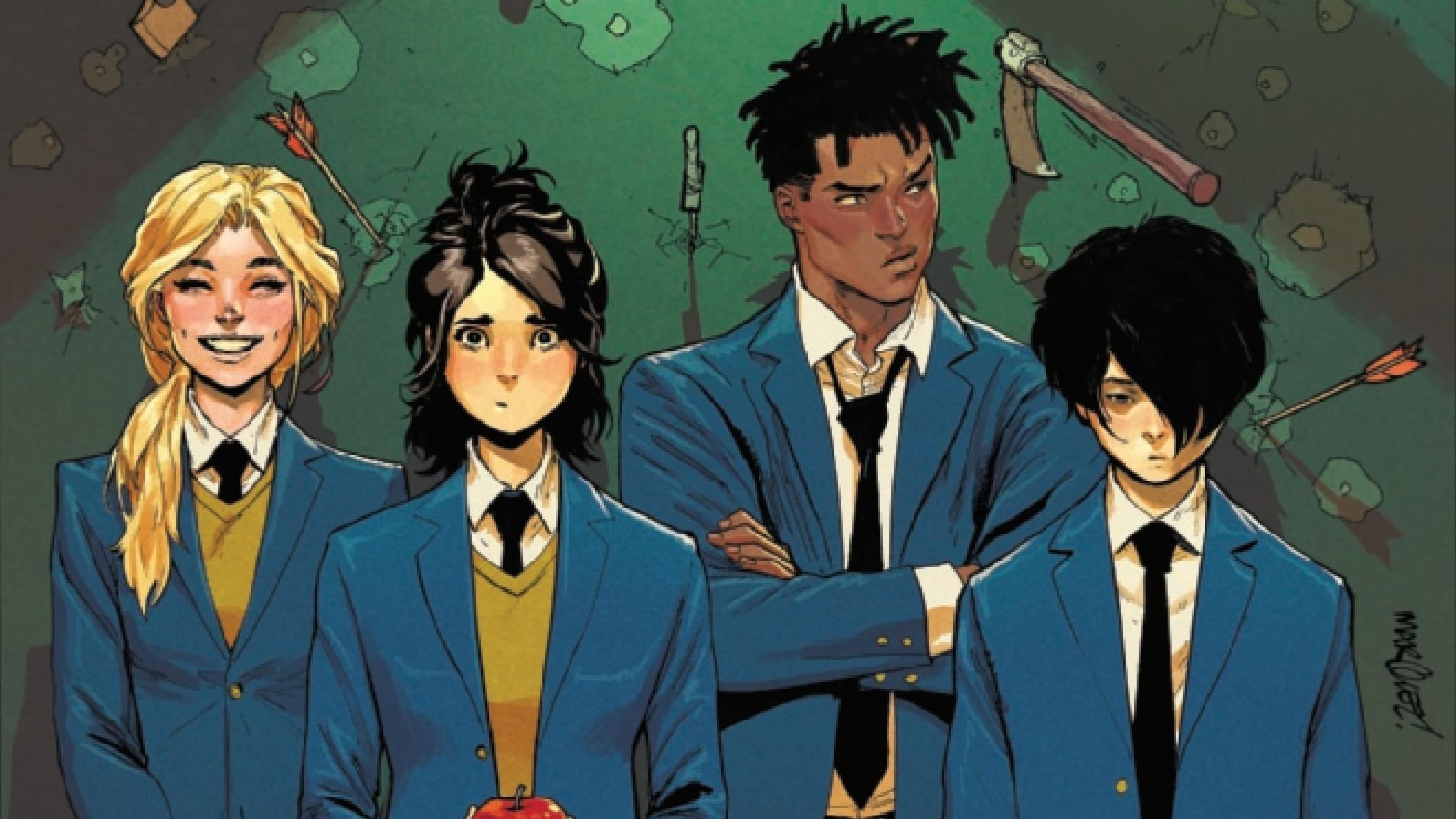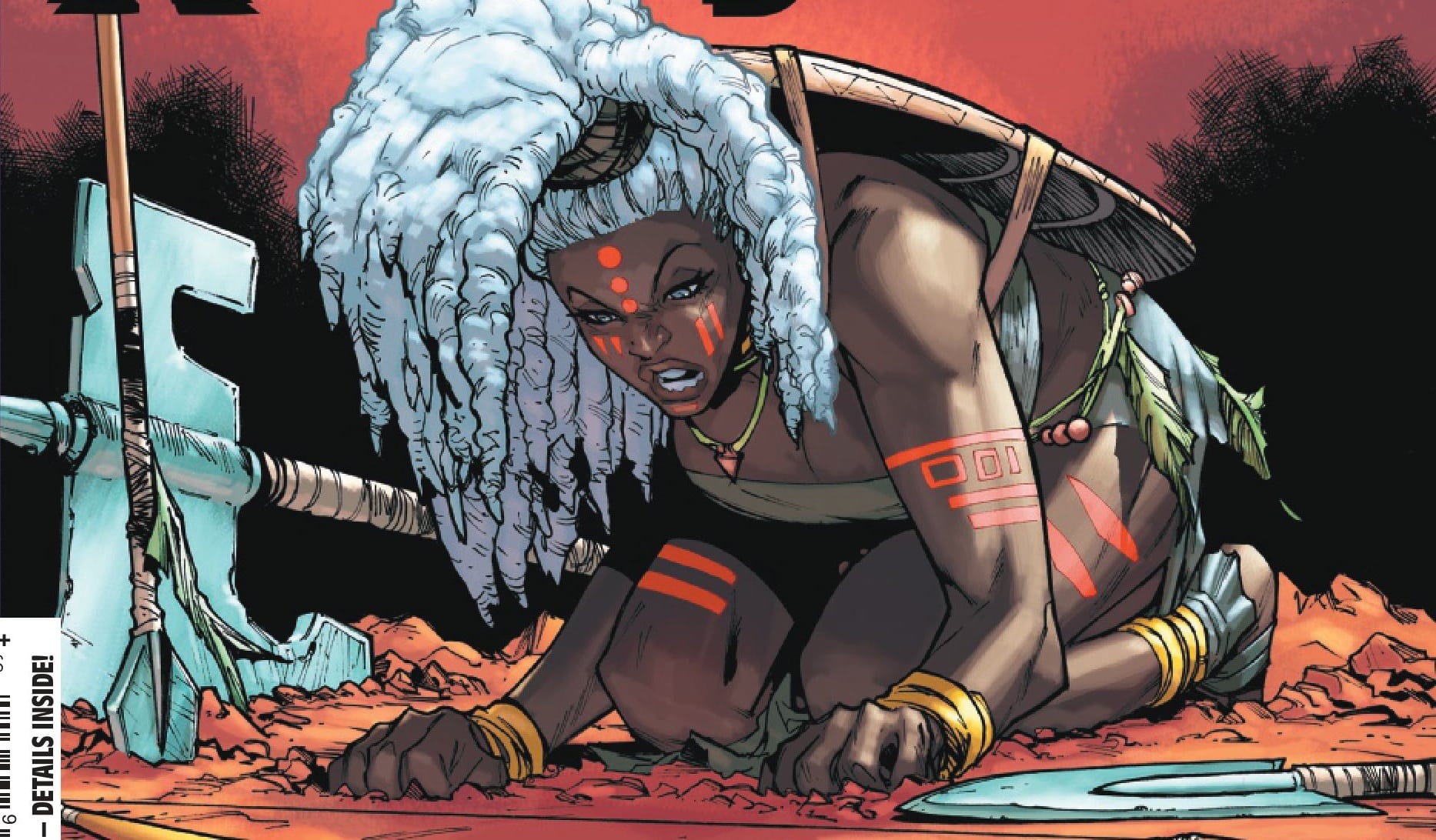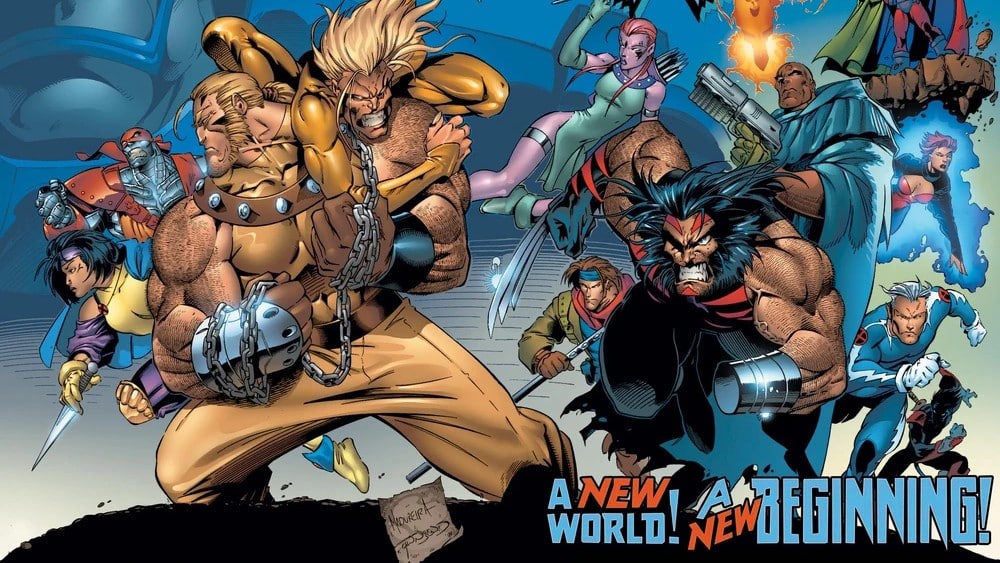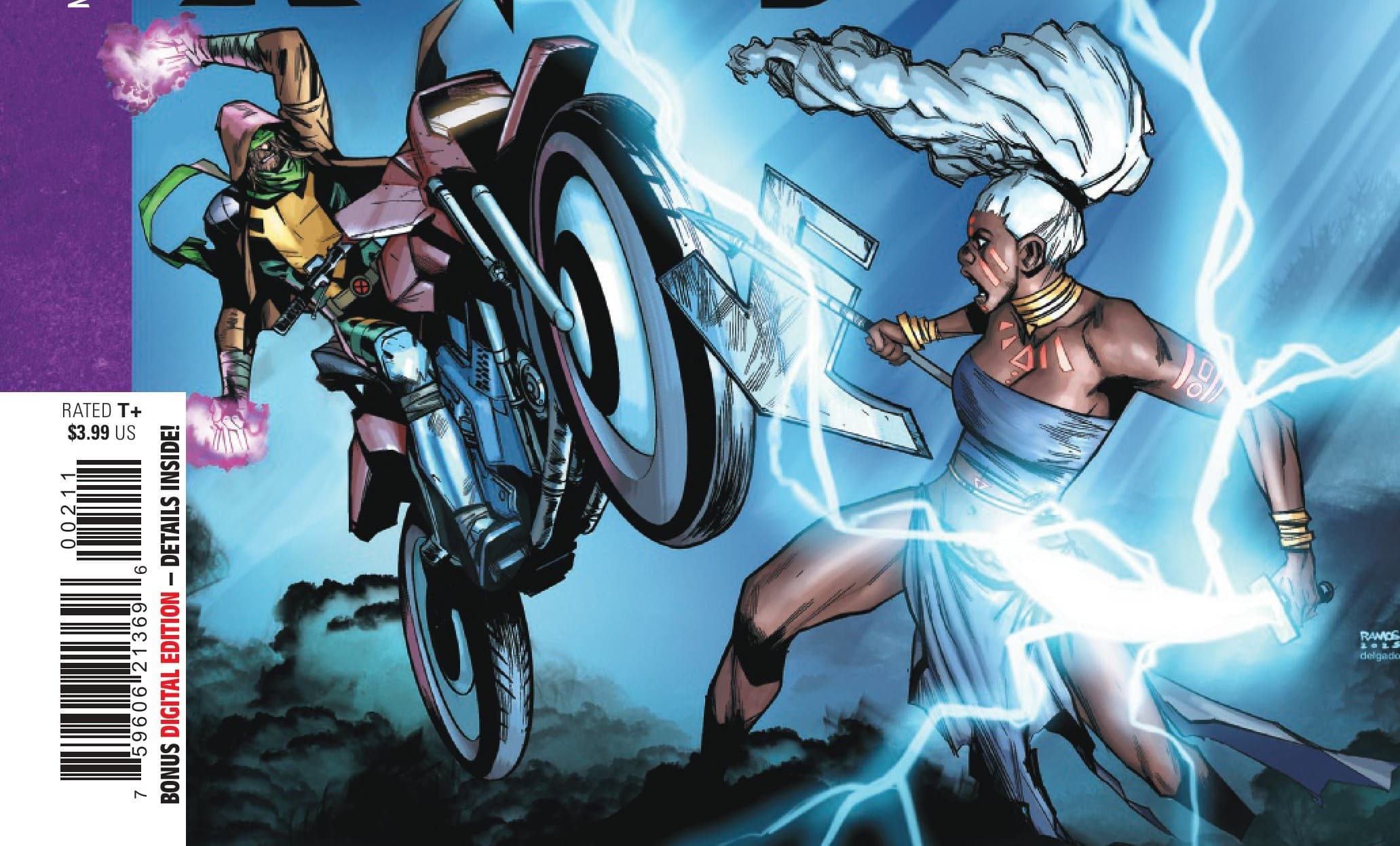It’s back to school for four young mutants, but is a rural school in Louisiana ready for this crew? Bullies, terrible lunches and classroom flirting abound, but is one of the student body the prophesied Endling who will be the last member of mutantkind? Uncanny X-Men #6 is written by Gail Simone, drawn by Javier Garron, colored by Matthew Wilson and lettered by Clayton Cowles.
Jake: Remember the days? Cold-meat sammiches, Zagg’s chips and a praline dessert; getting made fun of mere seconds after getting on the school bus; worrying you’d accidentally summoned a monster through the bathroom mirror. Does that bring back warm, fuzzy memories for you, Anna?
Anna: You forgot getting beaten up and kidnapped by anti-mutant bigots before you even have a chance to attend any classes. A circumstance that your current guardians maybe should have considered and helped, you know, guard against? But hey, maybe Rogue and the gang are just practicing some of that newfangled free-range parenting.
Jake: I have to admit, I’m partial to a bit of high school nostalgia. The problem a story about the so-called glory-years faces is that it’s been done so often that the parody genre is just as firmly established, and the worst thing you can do is fall into this trap accidentally. Of course, high school drama holds a very special place in X-Men history and in my heart. Anyone who knows me will know I’m a huge New Mutants fan, so a story about the Outliers in a school setting is on paper my kind of jam.
Anna: Me too, but it helps when the school part actually happens. Anyway, on to the review!
Ghost World

Anna: The basic plot of this issue involves the Outliers being told they have to attend high school, because it’s a rule of the house. Meanwhile, Jubilee and Nightcrawler go grocery shopping, and Logan is … well, we’ll get to Logan. I know we both have Thoughts.
Jake: Look, we’ve all seen a million high school movies. We know that the difference between a credible one and a cringey one is how authentic the bully’s dialogue is, how dated their language and references feel, and whether they are representative of the period in history the story is set in. We can all spot a cardboard cutout jock asshole who hammers on the new kid for whatever their point of difference is, chortles gormlessly with his football buddies and shoves kids into lockers from a mile off. These are tropes and story beats that are so firmly established that they often veer into parody.
Uncanny X-Men #6 falls right into this trap. Take the bus scene, for example: We have, within the first five panels, one or more of the Outliers being made fun of for 1) having a disability 2) being poor 3) being an orphan and, for good measure 4) being emasculated by not fighting the bullies. These beats are only repeated through the rest of the issue. There’s nothing about it that characterizes the time period the story is set in, no exploration of the culture and values of 2020s Louisiana, no incorporation of the fact that Gen Z kids are if not more inclusive then at least more aware of privilege and discrimination, etc. When you compare this issue to the way Eve Ewing writes the young mutants in Exceptional X-Men, which is authentic and contemporary, it feels quite bland and cliche.
Anna: I know the word cringey has become cringey (or maybe always was), but gosh, I found myself making a face through so much of this. There are little nuggets I like. I like that Deathdream is drawn outside himself to help (or at least want to help) others. That’s good character insight and development. There continues to be some kind of potential connection between Jitter and Ransom (he seems particularly protective of her). The stuff with Calico’s backstory is … fine. She’s clearly been infantilized and controlled by her mother, which explains some things about her. As for the rest of it?
I would basically second what you said, Jake. I wish there was something, anything, specific about this being a school in rural Louisiana. I wish we saw something, anything, of the school and its teachers and social groups before the mutant hunters show up and immediately take us away from this setting. Compared to the character building of Exceptional X-Men, and the exploration of post-Krakoa mutant culture in NYX, this book feels old-fashioned and out of step. This could be anyplace, anytime, starring any person who feels different for any reason.
To be fair, maybe that’s the point. There’s a letter printed in this issue that refers to what the letter writer interprets as the segregationist and borderline racist politics of the mutant population during the Krakoan era, and praising the current era as a counterpoint. Editor Tom Brevoort responds to the letter by saying, “We agree with you on this point completely!” While the letter writer and Brevoort are of course entitled to their opinions, I’ll confess that I felt a bit heartbroken to see this viewpoint (which was a common way of criticizing the Krakoa comics among a certain subset of fans) spotlighted in this way, at this moment. A minority group embracing separatism as power in the face of genocidal bigotry is not the same as being a victim of racist segregation. But a book like Uncanny X-Men #6 seems less interested in tackling the complexity of contemporary identity politics than creating something “timeless” and “universal” that’s largely unmoored from both real-world and in-story histories and contexts. While I understand why that supposed universalism might appeal to some folks, for me, it feels shallow — and makes me miss Krakoa more than ever.
Jake: While the Fall of X portion of Krakoa wasn’t devoid of these moments (which we wrote at length about in many reviews), it appears that we are back to the curing-metaphorical-racism-through-punching type of X-Men comics. What the letters pages you’ve referenced and other dispatches coming out of editorial have made very clear is that this oversimplification is entirely deliberate. They also seem very confident that there’s a commercial case for it. Only time will tell. My view is that this approach may produce well-written, beautifully drawn, entertaining comic books, but putting such a cap on the ambition of a piece of fiction is a sure-fire way to ensure that it won’t stand the test of time.
Anna: On the topic of keeping this comic devoid of deeper metaphors, I also can’t help noting the deliberate choice to have the jock bullies who torment the Outliers — and physically assault Ransom, Deathdream and Jitter specifically — be one white guy and one Black guy. Maybe this underscores the mutant metaphor; race and class are subsumed by anti-mutant bigotry. But, similar to the choice to use a Black woman as this series’ bigoted big bad, there’s also a whiff of disavowal here. It feels like the book is saying anti-mutant bigotry might be symbolically similar to racism, but is distinct from real-world racism, which this book isn’t about because some of the villains are Black, except their Blackness is just visual and not cultural, since it hasn’t, to date, been a factor in anyone’s actual characterization. I’d feel differently about it if we were exploring intersections of race and mutant-ness. But, as yet, this book has rather firmly rejected doing so.
Progressive for the ’50s

Anna: I would have thought this issue’s Very Special Episode moment would occur among the teens, but instead, it’s attached to the team’s oldest member. I don’t quite know where to start with this Logan storyline, but I bet Jake does.
Jake: I’m going to focus on the scene of Logan telling Rogue and Gambit about his bet with his war buddies that the last one to survive would win a bottle of tequila — particularly the way it presents Logan’s masculinity. The first thing I’ll say is that I recognize that undiagnosed PTSD is a significant issue among veterans of the armed forces, and that it’s great if this issue helped anyone find the help they need. I also feel the need to say that this is a very basic portrayal of masculinity. Part of this is down to execution, which I’ll come onto later, and the other is simply that Logan expressing his feelings is treated as though it’s some kind of major breakthrough in either the character or the “strong, silent type” male fictional trope generally.
To be clear, Wolverine expressing his grief to his friends, and his friends being supportive, are both great things. It’s still true that men should do this more and should be encouraged to do so by those close to them. The issue is that Wolverine revealing his grief and depression to his teammates has been done to death for practically 50 years now. Chris Claremont knew back in the ’80s that the way you build out the strong, silent type, alpha-masculine figure to give him complexity is by establishing relationships with others that are built on trust and loyalty that inspire him to confide in them. Longtime readers laugh about Wolverine’s tendency to take a young female mutant under his wing, Lone Wolf and Cub style, but it was an effective way of rebutting the toxic view of masculinity in an artful, non-explicit way. Maybe I’m being idealistic here because the idea that maybe we haven’t actually moved on that much in 40 years is too depressing to bear, but the discourse about masculinity is beyond this point now. Even if it isn’t, I find it frustrating that this comic is just repeating decades-old tropes and not pushing this or other story beats forward.
Putting that aside, the scene doesn’t achieve the emotional resonance or pathos it’s aiming for because of the execution. Firstly, using Chekhov’s tequila bottle, which was set up in a completely isolated scene of Logan comforting his last comrade on his deathbed back in issue #1, as a catalyst for Logan to just approach Rogue and Gambit and start blurting out his trauma is an uninspiring setup for a scene of this nature. Secondly, using dialogue to have Rogue shout some pop psychology about Logan’s mind and heart being “all-too-damn human” is a cheap form of exposition that robs the reader of interpreting the scene for themselves. Worst of all though is the revelation. Rogue turning her back to the camera before dropping the bombshell “PTSD. I’m saying you have PTSD” to Wolverine and Gambit (who are practically doing a spit take) makes the whole thing feel like a cheap soap opera. And yes, I know we’re supposed to celebrate the melodrama elements of X-Men comics in particular, but there’s an emotionally delicate nuance to the work of Paul Smith or Marc Silvestri, for example, that Javier Garron’s art simply doesn’t have here. Good storytelling allows the narrative to be developed through metaphor, implication and subtext, whereas this feels laid bare in a way that only serves to reveal the lack of substance at its heart.
Anna: I did somewhat of a spit take at the spit take page. Partly, it’s the art. While Javier Garron does a fine job filling in for David Marquez on this issue, his style is a bit “broader”; I can’t help but feel Marquez might have handled this moment with more subtlety. But dialogue-wise, too, it’s played like a huge revelation about a dirty secret in a way I frankly found baffling because — this isn’t the 1950s? You’re allowed to say PTSD, and it’s not a bad word or a startling concept? And, as you so eloquently described, it really shouldn’t be a startling concept to Logan, who definitely has PTSD, and surely knows he has PTSD, because he’s been around forever and actually isn’t (in my reading of the character) as emotionally ignorant as he’s being written here. Granted, we all have different takes on these characters who’ve been written very differently at different times. But in my heart of hearts, I’m very sure that if you told Logan he has PTSD, he’d grunt and say, “Probably. So what.” Would he want to talk about it? Maybe not. But he wouldn’t be unaware of it.
Also, can we talk about the fact that Logan is not only metaphorically but still literally blind? I’m not totally sure why Logan’s eyes haven’t regenerated after his battle with Sarah Gaunt. I guess it’s an ongoing mystery, and that’s fine if that’s what we’re doing. But this book has a tendency to try and talk me out of thinking too hard, and this feels like another example of that. Logan’s blindness is dangling there like a thing I’m supposed to accept, except that I’ve seen Logan regenerate from a drop of blood. So while I swear I’m trying my best to relax and enjoy the show and not be a Bad Nerd, I have Questions. Maybe the blindness is really just there to hammer home the fact that Logan can’t see clearly (get it??). If so, I think Rogue blurting out the emotional beat with all the subtlety of a teenager who watches too many pop psychology TikToks already hammered it pretty good.
Blood or cranberry juice?

Anna: This issue’s other interconnected subplot involves Kurt and Jubilee going shopping for groceries, which quickly devolves into Kurt bamfing off to save a girl from getting squashed by a bus, while Jubilee apparently gets abducted by disciples of Warden Ellis.
The Nightcrawler bit is fine, if something we’ve seen many times before. Kurt rescues someone, they’re scared because he looks like a demon, then not, because he’s Kurt and he’s great. This is another one of those instances where if you’re reading X-Men comics to see replays of the hits, you will likely recognize this scene and say, “Hey I recognize that!” and hopefully feel good about recognizing it. I’d prefer something that remixes or meaningfully adds to things we’ve seen many times before, but to each their own. I’m fully aware of the fact I’ve read and talked about and written about more Nightcrawler comics than is probably healthy for anyone, and thus become easily bored by comics that remind me of his basic deal. I’m sure other readers will feel differently, and that’s fine; it’s a cute scene for what it is.
But we do have something new, which is the reveal of Warden Ellis’ mutant hit squad, which seems to be composed, in this instance, of Toad, Blob and Siryn. At the risk of once again thinking too much, I wonder if Toad and Blob’s complex Krakoan journeys will factor into their current status quo. I’m gonna guess no, but hey, a girl can dream, since it’s disheartening to see them calling back to their Brotherhood of Evil Mutants days.
Thoughts on our second B-plot, Jake?
Jake: As you say, the shopping scene had all the hallmarks of the “mutants vs. the general public” scenes we’ve seen countless times before: a hapless police officer arriving on the scene five minutes too late, some Nightcrawler flirtation, the character who’s contributed the least dialogue so far being kidnapped. It was fine. Its most important function was to set up the “Raid on Graymalkin” event, the first of the From the Ashes era. I’m a little more optimistic about the nature of Siryn et al’s relationship with Warden Ellis. We’ve seen the horrendous conditions they’re being kept in and the punishment they’re being subjected to in the pages of Sentinels, so I’m hoping this is a partnership formed under extreme duress and there’s enough residual Krakoan loyalty to turn the tide.
What are your hopes/expectations going into our first event of the era, Anna?
Anna: I’m trying to keep an open mind. As you mentioned, Sentinels has helped add some context for the mutant prison that we’ve been missing in other books. And yet, we’ve also been promised that this is an “event” where we won’t need any tie-in materials to enjoy it. In theory, I appreciate that; events have historically been cash grabs as much as anything else. And yet, I’m suspicious of it also being another attempt to limit the size of the sandbox. If the editor is assuring me that the current X-books don’t meaningfully interconnect, why should I be excited about an event that promises not-connected interconnections? Guess we’ll see!
X-traneous Thoughts
- We’ve done really well to avoid dialect discourse in this review so far, but I have to point out that Logan delivers a “might could” that shocked me to my core. Now, I’m no expert on North American dialogues, but I’m fairly confident that “might could” is an American Southern and not Canadian idiosyncrasy. Anna, am I wrong? (Anna: While I have known rural Canadians to adopt slang from the American South that they have probably learned from contemporary country music, yes, I also found Logan talking like this incredibly off-putting.)
- To the school principal who flashed the midnight M at the kids: You suck. And not just because the midnight M is corny. Where are your student safeguarding procedures, man? His words to the kids getting bullied before his very eyes: “Good luck, kids.” GOOD LUCK? Mate, why don’t you do something about it? When he sees the bullying continue a few pages later he gives Ransom this look as if to say, “Hey, I hate racism and bullying as much as the next guy, but you know what’s worse? Stooping to their level.” I’ve saved this for the addendum because I didn’t want to analyze it seriously, but it’s honestly everything that’s wrong with this issue and the series in a nutshell. Deeply infuriating. “Good luck, kids”? Haul this idiot’s ass in front of the school board IMMEDIATELY. Sarah Gaunt wouldn’t stand for this.
- That said, I’m hoping we get more context for the school and its denizens; we interestingly see a kid reading an X-Men comic in one panel, which suggests, in conjunction with the principal’s inadequate but significant awareness of the mutant cause, that the school’s not simply or exclusively bigoted.
Buy Uncanny X-Men #6 here. (Disclaimer: As an Amazon Associate, ComicsXF may earn from qualifying purchases.)







